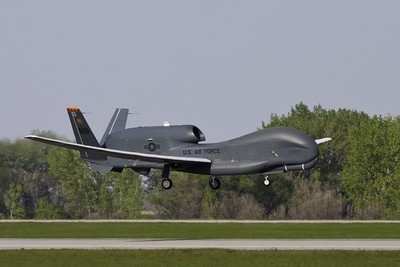Mon, Jun 06, 2011
Becomes Second UAS Main Operating Base In The U.S.
The U.S. Air Force and Northrop Grumman commemorated the arrival
of the first RQ-4 Global Hawk unmanned aircraft system (UAS) at
Grand Forks Air Force Base in North Dakota. The aircraft landed on
May 26 from Beale Air Force Base, CA. The arrival of the Global
Hawk also commemorates Grand Forks as the second main operating
base in the United States after Beale.

"Expanding the Global Hawk's mission of high altitude
intelligence, surveillance and reconnaissance in today's fight is
essential," said Brig. Gen. Paul H. McGillicuddy, 9th
Reconnaissance Wing commander. "Having this platform at Grand Forks
allows us the ability to fly more missions providing continuous
support to combatant commanders around the world."
Both Block 20 and 40 Global Hawks will be controlled from
Grand Forks. The Block 40 Global Hawk will deploy from the Grand
Forks main operating base to any location worldwide for both
military and humanitarian applications. "We are proud to celebrate
the arrival of the Global Hawk and establish Grand Forks as Global
Hawk's second main operating base," said George Guerra, HALE
Systems vice president, Northrop Grumman Aerospace Systems. "The
addition of a second main operating base will further enable Global
Hawk to provide 24/7 global coverage for both military and
humanitarian efforts."
Block 20 and 40 are alike in size, but differ in payload
configurations. The Block 40 Global Hawks are equipped with the
Northrop Grumman AN/ZPY-2 Multi-Platform Radar Technology Insertion
Program (MP-RTIP) sensor, built with teammate Raytheon Space and
Airborne Systems in El Segundo, Calif. The MP-RTIP is the first
radar sensor to concurrently usesynthetic aperture radar imaging,
while tracking moving targets simultaneously over large areas.

The RQ-4 Global Hawk flies up to 60,000 feet, above weather and
commercial air traffic. Global Hawk flies for more than 32 hours
per sortie at speeds approaching 340 knots. The MP-RTIP-equipped
Block 40 Global Hawk can persistently see through most types of
weather, day or night. As the world's first fully autonomous HALE
UAS, Global Hawk meets the global need for persistent intelligence,
surveillance and reconnaissance.
More News
Aero Linx: Model Aeronautical Association of Australia MAAA clubs are about fun flying, camaraderie and community. For over 75 years, the MAAA has been Australia’s largest fl>[...]
Touchdown Zone Lighting Two rows of transverse light bars located symmetrically about the runway centerline normally at 100 foot intervals. The basic system extends 3,000 feet alon>[...]
“Discovery and innovation are central to our mission at Virgin Galactic. We’re excited to build on our successful record of facilitating scientific experiments in subor>[...]
How To Get A Story On Aero-TV News/Feature Programming How do I submit a story idea or lead to Aero-TV? If you would like to submit a story idea or lead, please contact Jim Campbel>[...]
Student Pilot Reported That During Rotation, “All Of A Sudden The Back Of The Plane Kicked To The Right..." Analysis: The student pilot reported that during rotation, “>[...]
 ANN's Daily Aero-Linx (05.02.24)
ANN's Daily Aero-Linx (05.02.24) ANN's Daily Aero-Term (05.02.24): Touchdown Zone Lighting
ANN's Daily Aero-Term (05.02.24): Touchdown Zone Lighting Aero-News: Quote of the Day (05.02.24)
Aero-News: Quote of the Day (05.02.24) ANN FAQ: Contributing To Aero-TV
ANN FAQ: Contributing To Aero-TV NTSB Final Report: Cirrus Design Corp SR20
NTSB Final Report: Cirrus Design Corp SR20




